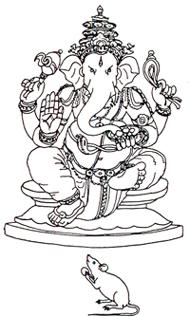|
 This dissertation on the significance of the elephant and its use or destruction
is pertinent for a critical study of Ganesha for the reason that Ganesha
idols are seen dominated by the head of the elephant. This makes the idols
of Ganesha, prima facie represent the material world of which the elephant
is the symbol. But since only the head of the elephant is preferred and
incorporated in Ganesha idols to the exclusion of the rest of its body,
this preference is significant, and the idols have to be studied in the
light of this preference. Ganesha being a male deity the head chosen for
him is the head of a tusker. The most peculiar organ seen in this head
is its prehensible nose called trunk. In all beings the breath of life
is the connecting link between the individual being and its relative world.
The elephant is no exception. The nose of the elephant is peculiarly a
movable organ. This organ generally is seen hanging down. But it can be
moved either to the left or right, or lifted up, without any impediment
to the breath of life or the breathing process. This dissertation on the significance of the elephant and its use or destruction
is pertinent for a critical study of Ganesha for the reason that Ganesha
idols are seen dominated by the head of the elephant. This makes the idols
of Ganesha, prima facie represent the material world of which the elephant
is the symbol. But since only the head of the elephant is preferred and
incorporated in Ganesha idols to the exclusion of the rest of its body,
this preference is significant, and the idols have to be studied in the
light of this preference. Ganesha being a male deity the head chosen for
him is the head of a tusker. The most peculiar organ seen in this head
is its prehensible nose called trunk. In all beings the breath of life
is the connecting link between the individual being and its relative world.
The elephant is no exception. The nose of the elephant is peculiarly a
movable organ. This organ generally is seen hanging down. But it can be
moved either to the left or right, or lifted up, without any impediment
to the breath of life or the breathing process.
In some idols of Ganesha the trunks hang down straight. In some, they
either turn towards the left side or the right side. These variations
are not made in any haphazard manner. There is some meaning with regard
to these variations. Although it is not correct to identify Ida Nadi with
the flow of breath in the left nostril and Pingala Nadi with the flow
of breath in the right nostril a convention appears to have been established
in iconography, to consider the left side of the idol of Ganesha as expressive
of the flow of Ida and the right side as expressive of the flow of Pingala.
In any idol of Ganesha if the trunk is hanging straight down it is indicative
of the unmanifested static reservoir of energy called Sushumna. If the
trunk is seen turning towards the left it is indicative of the flow of
Ida. If it is seen turning towards right it is indicative of the flow
of Pingala. The trunk turning towards the left side is invariably seen
reaching a bowl of modhaka (Laddus) which is indicative of the material
involvement of the mind in motion through the sense organs. The trunks
hanging down straight or turning towards right are seen in some idols
carrying a of nectar in the curve of their trunks. This is indicative
of the soul's attainment of immortality.
Ganesha figures with trunks turning towards the right are called Valampiri
Vinayakar. In South India many important temples have Valampiri Vinayakar.
In Kalady close to the place where Adi Shankara's mother was supposed
to have been cremated, there is an idol of Valampiri Vinayakar. Trunks
turning towards right is the symbol of the mind's spiritual progress through
the savya or Devayana path of light, highly commended by Adi Shankara
himself.
|